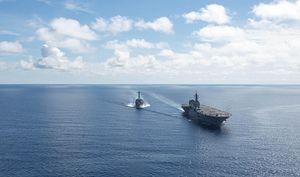Japan appears to be prepared to take the next step to convert its Izumo-class helicopter destroyers into VSTOL (vertical and/or short take-off and landing) aircraft carriers. According to several sources, the Japanese government has effectively decided to upgrade JS Izumo and JS Kaga to operate the F-35B Lighting II VSTOL stealth fighter. Studies conducted earlier this year concluded that such modification would be feasible, if deemed strategically necessary.
At the same time, Japan has decided to substantially increase its stake in the F-35. Reports now indicate that Japan will acquire another 100 F-35s, in addition to the 42 F-35As still on offer. At this point, it is not clear what the mix of F-35As and F-35Bs in this order would look like. It’s fair to say, however, that 100 F-35Bs would be substantially in excess of what the Izumos would need. It would be a strain for the Izumos to carry more than about a dozen F-35Bs each. For comparison, the United Kingdom expects to acquire 138 F-35Bs, divided between the Royal Navy and the Royal Air Force. The much larger Queen Elizabeth-class carriers are expected to operate two dozen F-35Bs, although they can surge much higher.
Thus, the decision to upgrade the Izumos necessarily suggests a follow-up question: Would Japan give serious thought to the construction of large fleet carriers after it has rebuilt its naval aviation experience with the Izumos? Since 2009, Japan has commissioned four large, flat-decked aircraft carrying vessels, beginning with the two 19,000 ton Hyugas and continuing with the two 27,000 ton Izumos. If, as it appears, Japan has determined that it is legally capable of operating fixed wing aircraft carriers, and that such carriers are operationally necessary, then it’s hardly a stretch to imagine that the next generation of Japanese aircraft carrier might approach something akin to a true fleet carrier, along the lines of the US America class or the British Queen Elizabeths. Such a vessel could carry F-35Bs or, with appropriate construction, either F-35Cs or some variant of Japan’s developing fifth generation fighter.
Japan has a long way to go before the Izumos can effectively operate as fixed-wing carriers. Modifying the ships will take time, but probably not as long as the painful process of rebuilding expertise in carrier operations. Down the road, Japan’s Maritime Self-Defense Force will need to remedy the anti-submarine warfare gap that converting the Izumos will necessarily create. Even with this step, Japan will find itself substantially behind China in carrier capabilities and carrier development. This is to say nothing, of course, about the negative reaction that Japanese aircraft carriers might inspire in China and South Korea. Still, Japan is a remarkably wealthy country with a vibrant shipbuilding industry, and is perfectly capable of re-establishing itself as a naval competitor to China.
The views expressed here are his personal views and do not necessarily reflect those of the Department of Defense, the U.S. Army, the Army War College, or any other department or agency of the U.S. government.

































